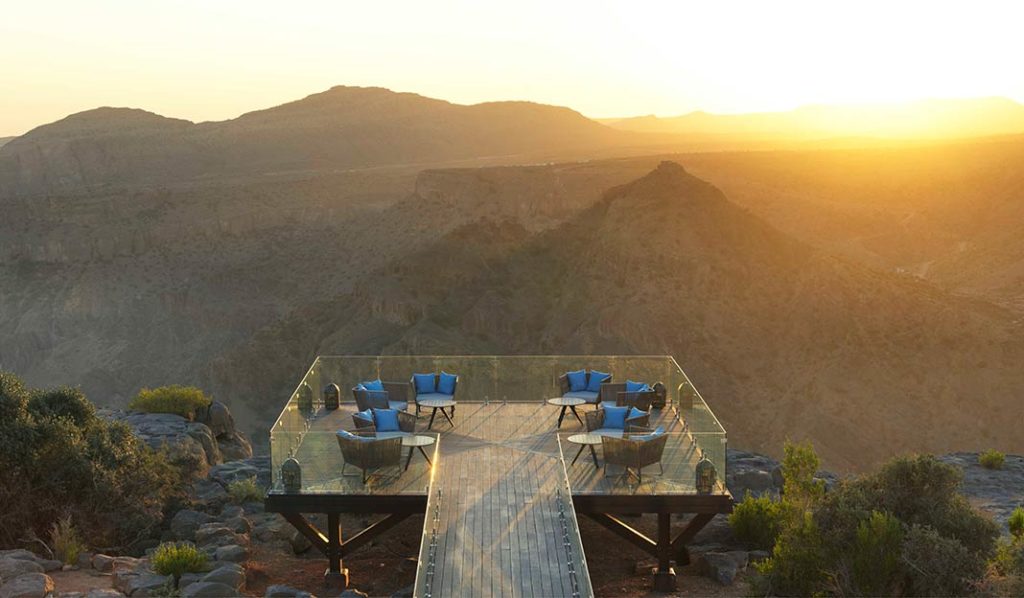
Perched over 2,000 metres above sea level on the curving rim of a great canyon in Jabal Akhdar, Anantara Jabal Akhdar Resort was designed by Atelier Pod, the award-winning firm which specialises in creating strong identities, merging brand values and environment specificities. The studio was chosen to create the architecture and interior design of the resort, after being shortlisted amongst ten internationally recognised design companies.
The long inaccessible Jabal Akhdar, Arabic for “The Green Mountain”, is a towering massif on the Sultanate of Oman’s vast Saiq Plateau. The luxury resort is located on a 66,000 m² cliff edge plot, with a total built-up area of 24,000m² including 115 keys, six restaurants and lounges, a signature spa and recreation facilities.
Before embarking on the journey, Lotfi Sidirahal, Atelier Pod’s principle, spent several days with his team visiting the area in order to fully identify with the site’s locality on architectural, communal, and traditional scopes before initiating the resort’s design. The immersive excursion included meeting the mountains’ communities, re-drawing the architectural and landscape details of Birkat al Mawz and Jabreen fort, and of course exploring the primitive vernacular typologies that testify to the people’s historical lifestyle. This exploration phase preceding the design task was crucial for the team in order for them to create a unique and contemporarily rooted resort within the extraordinary heritage of the region.
The Atelier Pod team perceived how forms, volumes, play of light, use of materials, construction and decorative details of traditional Omani architecture and interiors, not only displayed harmony of form and function, but also how it responded to the local climate and culture. The studio contemplated long and hard on how to draw from these conventions in the project’s inception, ranging from the simple massing in the design of Bahla Fort to the delicate elegance of Jabrin Castle. The approach of Atelier Pod involved the innovative adaptation of vernacular elements to express the essence of local heritage.
Key elements in the character of Oman’s architecture are integrated into the resort’s concept without overshadowing its design. The resort reflects the fortification typology of the Nizwa region’s stronghold, ensconcing guests in modern ramparts inspired by the commanding mountain citadels and re-imagined with sophisticated modern interiors.
The sense of drama and beauty is heightened by the play of light and shade, the texture of the natural materials, rustling vegetation, and the sound of flowing water.
The designer configures visitors’ experience in sequences in order to arouse distinctive emotions inspired by the view, the architecture, and the landscape.
Sidirahal explains:
"We designed the entrance with the idea of a fort in mind. The exterior, with its great wooden doors, impressively showcases commanding strength. There is a dramatic contrast upon entry as the interior gives a delicate and voluptuous impression with a majestic open courtyard featuring lush green terraces and a falaj."
In the lobby, the guests are greeted by a wooden geodesic dome spanning over ten metres in diameter with a peaceful contemporary fountain centred beneath it. As they make their way through to the central courtyard decorated by revisited Omani arcades, they can catch a first glimpse of a striking rectilinear frame, increasing the perspectival depth of the mountain silhouettes, stretching over the garden terraces and beyond to the dramatic gorge.
With a large open fireplace serving as a central focal point, the courtyard is unmistakably the heart of the resort. An emanating protective warmth contrasts with the breathtaking cliff-side, injecting an invading vastness in the pool, rooms, and villas. The patio brings together a souk, a coffee shop, a library, as well as pathways leading to the main restaurant and banquet facilities.
A freestanding tower on the western side of the courtyard is a testament to the ancient Omani Keep, or Burj, distinctive by its conical curvature and smooth encircling ramp, with an otherwise contemporary function. The tower houses a lounge and a specialty restaurant while also serving as an observation tower for a night under a blanket of stars. The rooftop was inspired by the high firing platforms of Nakhal Fort on one hand, and the rooftop courtyard of Jabreen Castle on the other.
Designed to incorporate a reinvented sense of timelessness in the vein of rooted luxury, the elegant interiors reincarnate the surrounding culture, exuding a minimalist style infused with warm, rich colours alongside traditional features represented in local artwork, Arabesque lanterns, and handmade pottery. Indigenous iconic mountain roses, pomegranates and marine fossils permeate design choices, as reflected in the décor and artwork.
Describing the eighty pieces of custom designed furniture as “contemporary interpretations of traditional Omani design”, the studio used the patterns and architectural details found in doorframes, ancient ceilings, and traditional chests in order to generate a complete furniture line adapted to luxury resort standards. As Sidirahal puts it: “We tried to continue the Omani design DNA by inventing the missing genes”.
The ultimate aesthetic is never in contradiction with its environment and yet never the same. A total of 115 luxury guest rooms and villas overlook either the dramatic canyon or tranquil gardens. The resort’s 82 Deluxe Rooms boast a spacious bedroom, amongst the largest in the country, and a spa-like bathroom complete with a rain shower and separate bath alongside a balcony. Meanwhile, the 33 One- or Two-Bedroom Villas grant guests an intimate escape, each with a private infinity pool overlooking the cliff or hiding in an exotic garden.
Other unique design elements include the spa, featuring the falaj-inspired canals, instilling the quiet sound of flowing water all throughout the resort. In the heart of the spa, a mysterious rough stone cube shields the sensual hammam, perpetuating the philosophy of contrast used by the designer.
The Omani tradition of integrating the ancient water channel system, called “falaj”, with cleansing spaces was adopted to offer intimacy to secluded areas around the spa. These areas harbour jacuzzis, daybeds, and hammocks.
comments